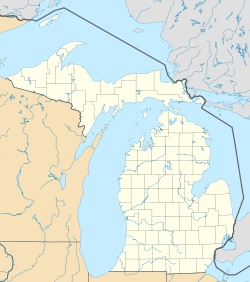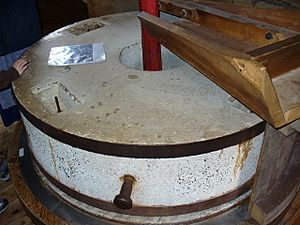De Zwaan (windmill) facts for kids
Quick facts for kids |
|
|
De Zwaan Windmill
|
|
 |
|
| Location | Windmill Island Gardens, 1 Lincoln Ave., Holland, Michigan |
|---|---|
| Built | 1761 |
| NRHP reference No. | 100002333 |
| Added to NRHP | April 17, 2018 |
De Zwaan is a real Dutch windmill located in Holland, Michigan. Its name means "The Swan" in Dutch. This special windmill is the oldest true, working Dutch windmill in the United States. You can find De Zwaan in the beautiful Windmill Island park.
Contents
The Windmill's Journey to Holland
Bringing a Piece of Dutch History
In the 1960s, people in Holland, Michigan, wanted to honor their city's Dutch roots. Willard Wichers and Carter Brown led a project to bring a real Dutch windmill to the United States. This was a big challenge!
Many windmills in the Netherlands had been damaged during World War II. Because of this, the Dutch government had stopped selling windmills to other countries.
Finding De Zwaan
Wichers and his team found a way to get special permission. They chose a windmill called De Zwaan that was badly damaged. This windmill had been working in a Dutch town called Vinkel since 1884.
De Zwaan was causing some disagreements in the Netherlands. Three local groups couldn't decide what to do with the damaged mill. So, the Dutch government decided to sell it to Wichers for $2,800. De Zwaan became the very last windmill to leave the Netherlands.
Rebuilding the Windmill
In October 1964, De Zwaan arrived in the United States. It traveled by ship and then by truck to Windmill Island in Holland, Michigan. It took about six months to put the windmill back together.
The city built a tall base for the windmill. This was like its original design from 1761. When it was finished, the city celebrated De Zwaan as a windmill that was over 200 years old!
Opening to the Public
In April 1965, the 125-foot (38 m) tall windmill officially opened. It stands on Windmill Island, which is a 36-acre (150,000 m2) park. This park was once a swamp near Lake Macatawa.
De Zwaan is open to visitors from late April through early October each year. When the wind blows just right (around 15 to 20 mph (7 to 9 m/s) from the west), its huge 80-foot (24 m) wide blades spin.
Discovering De Zwaan's True Story
Celebrating 50 Years
In 2015, Holland, Michigan, celebrated De Zwaan's 50th anniversary in the city. For this celebration, Alisa Crawford, who is De Zwaan's resident Miller and historian, started writing a book about the windmill.
Alisa Crawford is very special. She has a master's degree in museum studies. She is also the only person in the United States who is a certified Dutch miller. She earned this after many years of studying while working at De Zwaan.
A Surprising Discovery
While researching for her book, Alisa found something amazing. She learned that the De Zwaan windmill in Krommenie (where it was thought to be built) was taken down in 1887. This was three years after the De Zwaan in Holland, Michigan, was moved to Vinkel.
This meant there had been at least two windmills named De Zwaan in the Netherlands!
The Real History of De Zwaan
Alisa Crawford proved that the De Zwaan windmill in Holland, Michigan, actually started its life in Dordrecht, Netherlands, in 1833. It was first a sawmill, used to cut wood.
In 1884, the mill started using steam power instead of wind. So, its old parts like the body, cap, and blades were no longer needed. The Van Schayk family bought these parts to move them to Vinkel. They also bought parts from another mill called Nooitgedacht, which had been built in 1800.
This discovery showed that De Zwaan was about 70 years younger than people thought when it came to Holland in 1964. It was also a "hybrid" mill, made from parts of two or even three different windmills!
Why De Zwaan is Still Authentic
Alisa Crawford explains that this mix of parts makes De Zwaan truly "authentic." Windmills are like working machines. When they break, they get fixed. When parts wear out, they are replaced. If they become old-fashioned, they are used for new purposes.
Because of this, De Zwaan's unique history makes it a real and important Dutch windmill.
A National Historic Landmark
Honoring De Zwaan
After her book, De Zwaan: The True Story of America's Authentic Dutch Windmill, was published, Alisa Crawford wrote a special request. She asked for De Zwaan to be added to the National Register of Historic Places.
In 2018, the windmill was officially listed on the National Register of Historic Places. This means it's a very important historical site in the United States.
State Historic Marker
In 2019, the City of Holland put up a State Historic Marker at De Zwaan. This marker tells visitors about the windmill's history. One side of the marker says:
In 1961 Castle Park resort owner Carter P. Brown proposed the idea of creating a public park with "an authentic Dutch windmill," a symbol of Holland's Dutch heritage. To do so, city officials needed permission from the Dutch government, which protects windmills as national monuments. Willard C. Wichers, Midwest director for the Netherlands Information Service, led negotiations with the Dutch over a three-year period. In June 1964 he travelled to the Netherlands to find a suitable mill and finalize arrangements to buy and move it. In Vinkel, Noord-Brabant, stood a mill that had been built in 1884 using pieces from older mills. Named De Zwaan (the Swan), it had been damaged during World War II and had deteriorated. Dutch officials allowed its sale but required that Dutch millwright Jan D. Medendorp supervise its relocation and restoration.
See also




